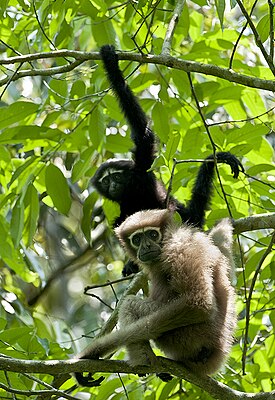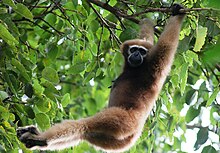White-browed gibbons
| White-browed gibbons | ||||||||||||
|---|---|---|---|---|---|---|---|---|---|---|---|---|

Male (back) and female (front) of the western white-browed gibbon ( H. hoolock ) |
||||||||||||
| Systematics | ||||||||||||
|
||||||||||||
| Scientific name | ||||||||||||
| Hoolock | ||||||||||||
| Mootnick & Groves , 2005 |
The white- browed gibbons or Hulocks ( Hoolock ) are a genus of primate from the family of the gibbons (Hylobatidae). A distinction is made between a western ( H. hoolock ) and an eastern species ( H. leuconedys ), which were originally listed as subspecies of a single species ( H. hoolock ). In January 2017, another type of Hoolock gibbons was described. The distribution area of Hoolock tianxing is even further east than that of the eastern white- browed gibbon.
features
The head body length is up to 81 cm. White-brow gibbons weigh up to 9 kg, the females are usually lighter. Although the sexes are of the same size, they differ significantly in terms of coat color. Adult males and juveniles are colored black with the exception of the white eyebrows. Females, on the other hand, are gray-brown with dark brown cheeks and a white ring around the entire face. The females of the eastern species are clearly more contrasting in color. They have a dark brown belly, sand-colored arms and legs and an almost completely white head.
distribution and habitat
White-browed gibbons have the most north-westerly distribution area of the whole family, it stretches across northeast India ( Assam , Meghalaya ) and Myanmar ; small remnants (a few hundred animals each) also live in eastern Bangladesh and south-western China ( Yunnan ). In the east, the Saluen forms the limit of its range; Chindwin and Irrawaddy separate the three types.
White-browed gibbons mostly inhabit tropical rainforests, evergreen and semi-evergreen forests, deciduous mountain forests, and moist deciduous forests. They occur at heights of up to 2700 m. Occasionally they are also found in bamboo thickets and plantations. Sometimes they walk on the ground to reach solitary, fruiting trees, especially in areas where their habitat is extremely fragmented, destroyed, or near settlements. Although they eat and sleep here, they are unable to survive in monocultures.
Way of life and reproduction
White-browed gibbons live in family groups of up to 6 animals (but mostly 3), which consist of a male and his female and their young. The females dominate the males. They travel up to 1,800 m in one day through their 400 hectare territories. They spend the day mainly searching for food (25%) and eating (30%), resting (27%) and hiking through their territories (7%). Grooming and playing are less important. The animals usually move through the branches by swinging (brachiation).
The gibbons usually perform their chants in the morning before they have left their sleeping places, but they can also be heard in the evening. They tend to sing double solos rather than perform duets.
Young trees are preferred as sleeping places. The female and her infant usually sleep with the male. Older children sleep individually.
Foraging often takes place in the morning hours, while resting begins in the early evening. Their activity ends several hours before sunset to prevent possible competition for food with other primates. The white-browed gibbon is mainly a fruit eater, preferring ripe and fleshy fruits. But leaves, stems, flowers, buds, seeds, shoots, mosses and lichens, insects, spiders and bird eggs are also on the menu. Nevertheless, with 65% fruits represent the largest part of the diet (especially figs ficus ). In addition, they eat 13% of leaves, 12% of stems, 5% of flowers and 5% of animal protein. When fruits are scarce, they eat more leaves. In the Borajan Wildlife Conservation Area, the gibbons mainly eat bamboo stalks, with fruits only making up 40% of their diet. In northeast India they are important seed dispersers of large, small fruit-bearing trees.
The mating season falls in the rainy season, May to June. Most births occur in the dry season between November and February. The offspring are suckled for over two years. The interval between births is usually 3 years. Young white-browed gibbons are born after a gestation period of around seven months and have a milky-white fur. After about half a year it turns black. They reach their final coat color when they reach sexual maturity, which occurs at the age of 8 to 9 years. Their life expectancy in the wild is around 25 years.
Hybrids between the western white-browed gibbon and the white-hand gibbon are known from Myanmar on the Salween River. In addition, the two subspecies of the white-browed gibbon hybridize on the upper Chindwin River near Dalu. An introduced population of the eastern white-browed gibbon lives in Arunachal Pradesh in northeast India in the range of the western species, where hybrids also occur.
threat
The western white-browed gibbon ( H. hoolock ) is classified as “endangered” (endangered) by the IUCN , the population of the eastern white-browed gibbon ( H. leuconedys ) is classified by the IUCN as “vulnerable” (endangered).
Systematics and naming
The scientific name of this genus has changed several times. The originally only species ( H. hoolock ) with two subspecies was traditionally classified as all gibbons in the genus Hylobates ; later it received - also due to the different number of chromosomes - its own genus as Bunopithecus . The genus name comes from the extinct species Bunopithecus sericus , which, however, according to recent findings is not closely related to the white- browed gibbons. That is why the new generic name Hoolock was introduced in 2005 . In more recent publications, both subspecies are classified as separate species.
literature
- Thomas Geissmann: Comparative Primatology . Springer, Berlin 2003, ISBN 3-540-43645-6 .
- Russell A. Mittermeier , Anthony B. Rylands, Don E. Wilson : Handbook of the Mammals of the World. Volume 3: Primates. Lynx Edition, Barcelona 2013, ISBN 978-84-96553-89-7 , pp. 779-780.
Individual evidence
- ↑ Peng-Fei Fan, Kai He, Xing Chen, Alejandra Ortiz, Bin Zhang, Chao Zhao, Yun-Qiao Li, Hai-Bo Zhang, Clare Kimock, Wen-Zhi Wan, Colin Groves , Samuel T. Turvey, Christian Roos, Kristofer M. Helgen, Xue-Long Jiang: Description of a new species of Hoolock gibbon (Primates: Hylobatidae) based on integrative taxonomy. American Journal of Primatology, January 2017, DOI: 10.1002 / ajp.22631 .
-
↑ International Zoo Yearbook. 1974, p. 373;
- International Zoo Yearbook. 1977, p. 307. - ^ Colin P. Groves: Systematics and phylogeny of gibbons. In: Gibbon and Siamang Volume 1, 1972, pp. 1-89; P. 67.
- ^ J. Das et al .: First distribution records of the eastern hoolock gibbon (Hoolock hoolock leuconedys) from India. In: Zoos' Print Journal 21, No. 7, 2006, pp. 2316-2320.
- ↑ a b Hoolock hoolock in the endangered Red List species the IUCN 2008. Posted by: Brockelman, W., Molur, S. & Geissmann, T., 2008. Accessed May 26, 2016th
- ↑ a b Hoolock leuconedys in the endangered Red List species the IUCN 2008. Posted by: Brockelman, W. & Geissmann, T., 2008. Accessed May 26, 2016th
- ↑ Alejandra Ortiz, Varsha Pilbrow, Catalina I. Villamil, Jessica G. Korsgaard, Shara E. Bailey, Terry Harrison: The Taxonomic and Phylogenetic Affinities of Bunopithecus sericus , a Fossil Hylobatid from the Pleistocene of China. PlosOne, 2015, doi: 10.1371 / journal.pone.0131206
- ↑ Mootnick, AR and CP Groves : A new generic name for the hoolock gibbon (Hylobatidae) . In: Int. J. Primatol . 26, 2005, pp. 971-976. doi : 10.1007 / s10764-005-5332-4 .
- ↑ David J. Chivers, Martina V. Anandam, Colin P. Groves, Sanjay Molur, Benjamin M. Rawson, Matthew C. Richardson, Christian Roos, Danielle Whittaker: Family Hylobatidae (Gibbons). in Russell A. Mittermeier , Anthony B. Rylands & Don E. Wilson : Handbook of the Mammals of the World. Volume 3. Primates. Lynx Editions, 2013 ISBN 978-8496553897 , pp. 779-780.

